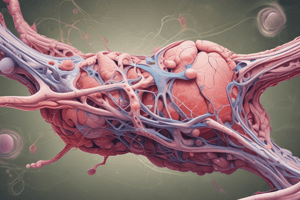Podcast
Questions and Answers
What is the main function of epithelial tissue?
What is the main function of epithelial tissue?
- Providing support
- Transmitting signals
- Creating movement
- Separating body surfaces (correct)
At which level are tissues grouped together to form a functional unit?
At which level are tissues grouped together to form a functional unit?
- Extracellular level
- Tissue level (correct)
- Organ level
- Cellular level
Which type of tissue consists of specialized cells that contract to create movement?
Which type of tissue consists of specialized cells that contract to create movement?
- Connective tissue
- Epithelial tissue
- Muscle tissue (correct)
- Nerve tissue
What is the role of nerve tissue in living organisms?
What is the role of nerve tissue in living organisms?
Which level consists of multiple tissues working together to form an organ?
Which level consists of multiple tissues working together to form an organ?
What distinguishes connective tissue from other types of tissues?
What distinguishes connective tissue from other types of tissues?
Which type of tissue in animals lines body surfaces and covers organs?
Which type of tissue in animals lines body surfaces and covers organs?
What is the function of connective tissue in animals?
What is the function of connective tissue in animals?
Which type of plant tissue conducts sugars, water, and other organic solutes from the leaves to other parts of the plant?
Which type of plant tissue conducts sugars, water, and other organic solutes from the leaves to other parts of the plant?
What is the main function of muscle tissue in animals?
What is the main function of muscle tissue in animals?
Which type of animal tissue consists of neurons that transmit signals throughout the body?
Which type of animal tissue consists of neurons that transmit signals throughout the body?
What is the main function of glandular tissue in animals?
What is the main function of glandular tissue in animals?
Flashcards are hidden until you start studying
Study Notes
Tissues: The Building Blocks of Life
Tissues are fundamental units of living organisms, grouping together similar cells with specialized functions that work together to perform various tasks. They are the building blocks that make up the structure of plants and animals, forming the foundation for their complex systems. In this article, we'll explore the various types, structures, functions, and differences between plant and animal tissues.
Types of Tissues
There are four main types of tissues:
- Epithelial tissue: Thin sheets of cells that line body surfaces and coverings inside and outside the body, separating them from their environment.
- Connective tissue: A diverse group of cells and extracellular matrix that hold tissues and organs together, provide support, and transport nutrients.
- Muscle tissue: Consisting of specialized cells that contract to create movement.
- Nerve tissue: Composed of cells called neurons that transmit signals throughout the body.
Structure of Tissues
Tissues are organized into three main levels:
- Cellular level: Consisting of individual cells that interact in various ways, depending on the tissue type.
- Tissue level: Grouping together of similar cells to form a functional unit.
- Organ level: Multiple tissues working together to form an organ, which performs a specific function.
Functions of Tissues
Different tissues have specialized functions:
- Protection: Skin, the outermost tissue in animals, and the epidermis in plants, protect the organism from physical and chemical threats.
- Barrier: The endothelium, found in blood and lymph vessels, and the pericardium, surrounding the heart, create barriers to protect organs and tissues.
- Transport: Connective tissues, such as blood and lymph, transport nutrients, oxygen, waste products, and hormones throughout the body.
- Support: Bones, tendons, and ligaments provide structural support in animals, while xylem and phloem provide structural support and transport water and nutrients in plants.
- Absorption: Roots and the lining of our gastrointestinal tract absorb water, minerals, and nutrients.
- Storage: Adipose tissue stores energy, and the parenchyma in plants stores nutrients.
- Excretion: The kidney and liver remove waste products, toxins, and excess water.
- Sensation and response: Skin and inner ear tissues detect and respond to external stimuli.
- Movement: Skeletal muscle, smooth muscle, and cardiac muscle contract to create movement.
- Communication: Nerve tissues transmit signals throughout the body.
Plant Tissues
Plants have six main types of tissues:
- Epidermis: Provides protection to leaves and stems.
- Dermal tissue: Protects the vascular tissues in stems and roots.
- Ground tissue: Consisting of parenchyma, collenchyma, and sclerenchyma. a. Parenchyma: Stores nutrients, water, and chlorophyll. b. Collenchyma: Provides structural support and flexibility. c. Sclerenchyma: Provides structural support and rigidity.
- Vascular tissue: Consisting of xylem and phloem. a. Xylem: Conducts water and nutrients from roots to other parts of the plant. b. Phloem: Conducts sugars, water, and other organic solutes from the leaves to other parts of the plant.
Animal Tissues
Animals have five main types of tissues:
- Epithelial tissue: Lines body surfaces and covers organs, such as the skin, respiratory tract, and digestive tract.
- Connective tissue: Provides support and connects various tissues and organs.
- Muscle tissue: Consists of three types of muscle fibers (smooth, skeletal, and cardiac) that produce movement.
- Nerve tissue: Consists of neurons that transmit signals throughout the body.
- Glandular tissue: Produces hormones, enzymes, and secretions.
Now that you have a basic understanding of tissues, their types, structures, functions, and differences between plant and animal tissues, you'll be able to appreciate the intricate and complex systems that they create in living organisms.
Studying That Suits You
Use AI to generate personalized quizzes and flashcards to suit your learning preferences.




